Today I’ll show you some more advanced SQL moves! Okay, I’d rather put them into the intermediate category. They are not beginner things — but it’s also for sure that junior data scientists can’t live without them.
In this article, I’ll show you:
- subqueries,
- SQL
CASEand - SQL
HAVING
These will definitely bring your SQL game to the next level and make you more efficient at your daily job. (Or if you don’t have a job yet, they will help impress the interviewer at your SQL screening interview.)
Note: to get the most out of this article, I recommend not just reading it, but actually doing the coding part with me!
Before we start…
… I suggest going through these articles first – if you haven’t done so yet:
- Set up your own data server to practice: How to set up Python, SQL, R and Bash (for non-devs)
- Install SQL Workbench to manage your SQL stuff better: How to install SQL Workbench for postgreSQL
- SQL for Data Analysis ep1 (SQL basics)
- SQL for Data Analysis ep2 (SQL WHERE clause)
- SQL for Data Analysis ep3 (SQL functions and GROUP BY)
- SQL for Data Analysis ep4 (SQL best practices)
- SQL for Data Analysis ep5 (SQL JOIN)
How to Become a Data Scientist
(free 50-minute video course by Tomi Mester)
Just subscribe to the Data36 Newsletter here (it’s free)!
Thank you!
You have successfully joined our subscriber list.
SQL subqueries (query within a query)
There are some cases in which a simple SQL query isn’t enough to answer your question. Open your SQL Workbench and let’s start with an easy task (we will use our flight_delays data set again):
Select the average departure delay by tail numbers (tailnum column) from the table – and return the minimum and maximum values of these calculated averages.
Note: Let’s try to solve it with the tools we have learned so far!
This is the solution:
SELECT tailnum, AVG(depdelay) AS avg_dd FROM flight_delays GROUP BY tailnum ORDER BY avg_dd;
Well, at least… as far as we can get with the tools we’ve learned so far.
The result is:
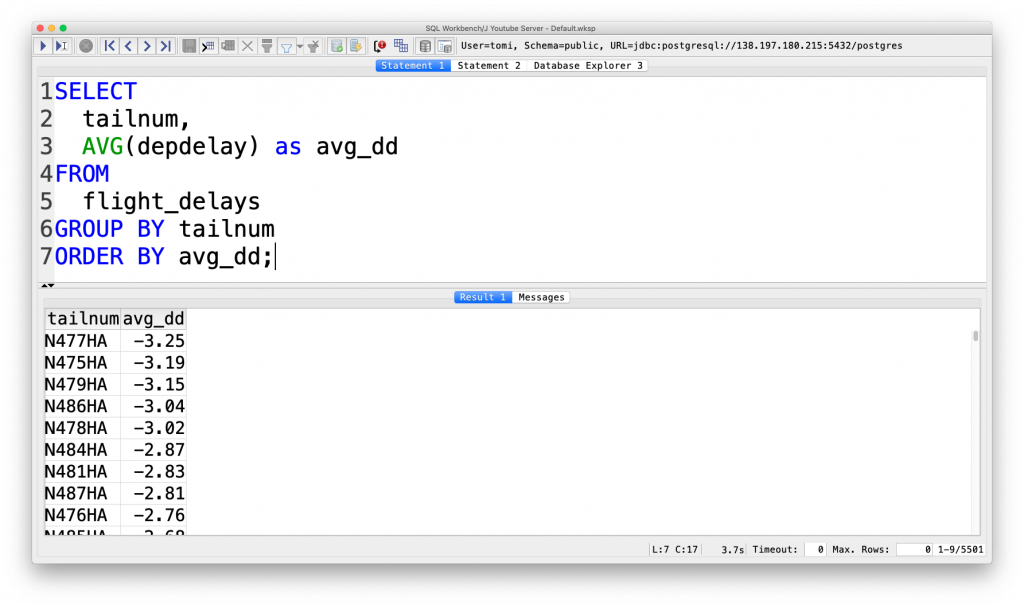
Nice. Except that this is not the 100% correct answer for this question. Sure, you can scroll down to see the highest value in the avg_dd column and you can scroll back up for the lowest value. But I don’t like that. It’s not just inelegant, but in real life data science projects quite often it’s not enough. If your automated script needs two specific values, you can’t scroll through manually. You’ll need to provide those two specific values. Period.
SQL-wise, the problem is that you have already run a function on your original table (AVG(depdelay)). And in SQL, you can’t use nested functions, like MIN(AVG(depdelay)). You can even give it a try:
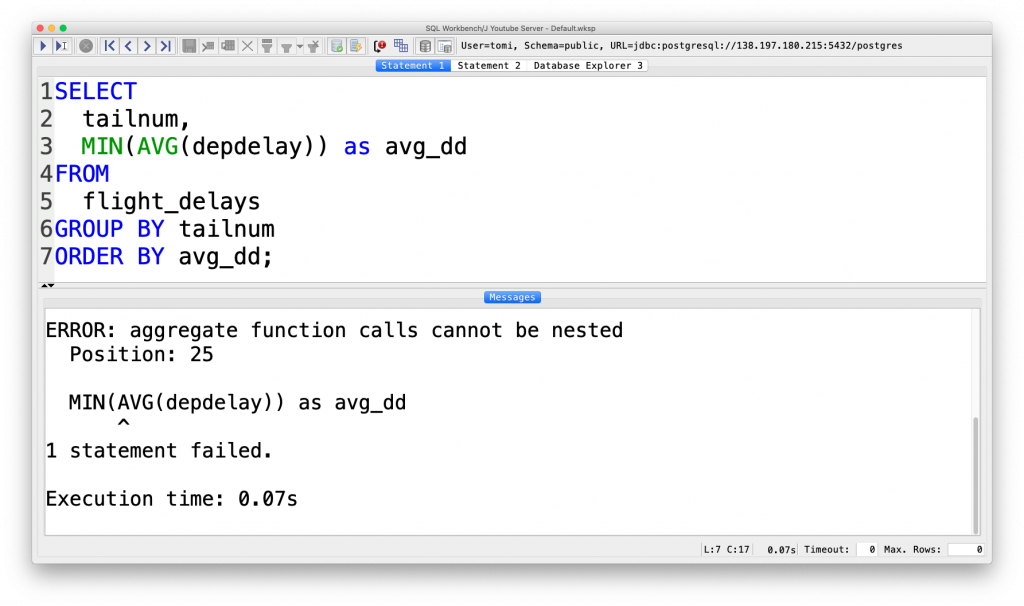
It’ll just throw an error.
At this point you can’t solve the problem with your original query, so you have two choices:
- You can create a new table and put this result there. Then you can run your
MIN()andMAX()functions on that freshly created table… This is not the preferred way, because it’s a bit complicated – and it’s not too flexible either. - A better solution is to handle the result of this query as if it was a new table – but in reality, put it as a subquery into another query.
Like this:
SELECT
MIN(avg_dd),
MAX(avg_dd)
FROM
(SELECT
tailnum,
AVG(depdelay) AS avg_dd
FROM
flight_delays
GROUP BY tailnum
ORDER BY avg_dd) AS my_original_query;
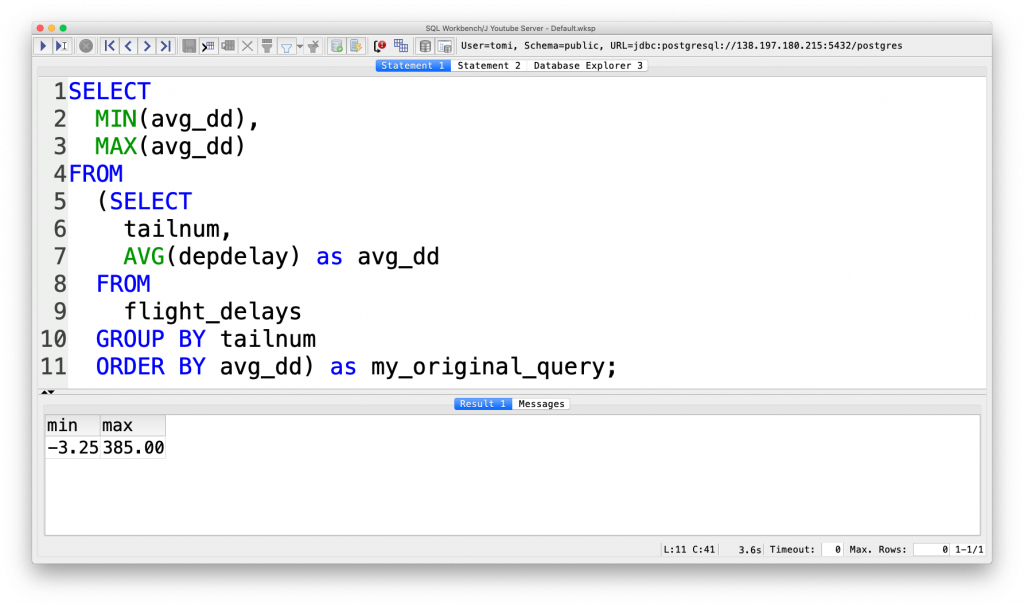
If it looks complicated let me simplify it:
SELECT MIN(avg_dd), MAX(avg_dd) FROM ([your_first_query]) AS [some_name];
Pretty cool. We have just gotten the results and you have just learned that after the FROM keyword you can always use subqueries instead of tables. And just to let you know, it doesn’t apply only to the FROM keyword (e.g. you can do it with WHERE, too.)
Note 1: While this solution is very handy, I have to admit that sometimes creating new tables is more efficient in terms of CPU-time. That would be a bit too advanced of a topic, so I won’t go deeper into it in this article.
SQL subquery syntax requirements
When you use subqueries in SQL, you have to be very careful with the syntax. To be more specific, watch out for these two things:
- your inner query must go between parentheses (
(and)) - your inner query must get a new “name” with aliasing — so after the parentheses add this:
AS new_name… except that of course you should replacenew_namewith something more meaningful. 🙂
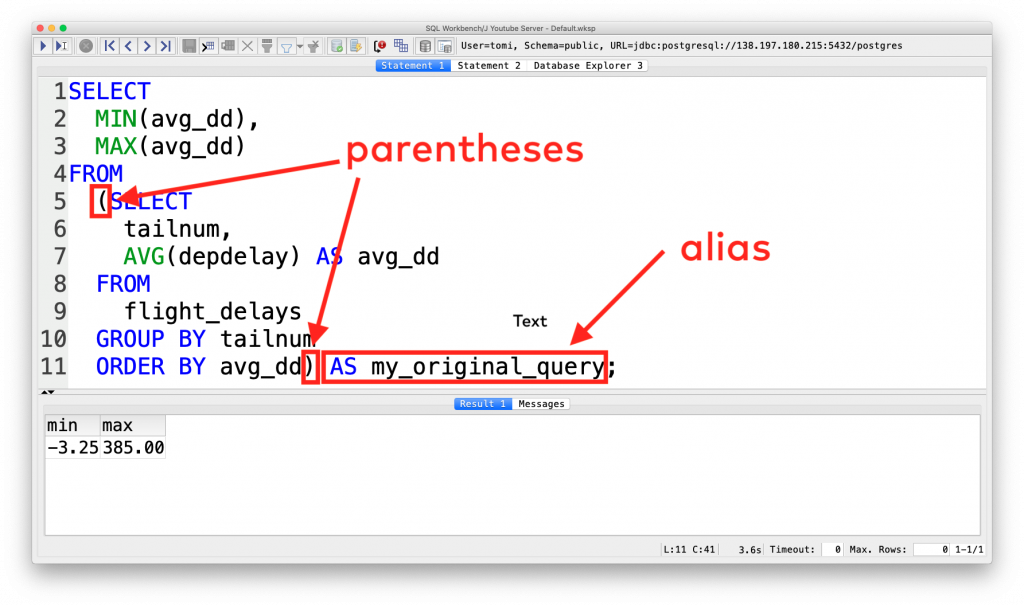
Test yourself #1 (with subqueries)
If you get the concept, here’s another SQL exercise to test yourself with!
- Calculate the total of the distances flown by each plane… (Note: do the grouping based on the
tailnumcolumn — andSUMthe values in thedistancecolumn) - …then take only those planes for which this total distance is greater than 1,000,000…
- then calculate the average of the total distances flown by these planes!
Hint 1: this might be a somewhat complex query. I recommend first trying to sketch and design on paper how it will work!
Hint 2: The result will be one number: 1311745.90
3… 2… 1… Go!
.
.
.
Here’s my solution…
(… but I’m pretty sure that there are other SQL queries that would deliver the same result. Drop me an email if you have one — I’ll review it for you!)
SELECT AVG(dist) FROM (SELECT tailnum, SUM(distance) AS dist FROM flight_delays GROUP BY tailnum) AS dist_by_plane WHERE dist > 1000000;
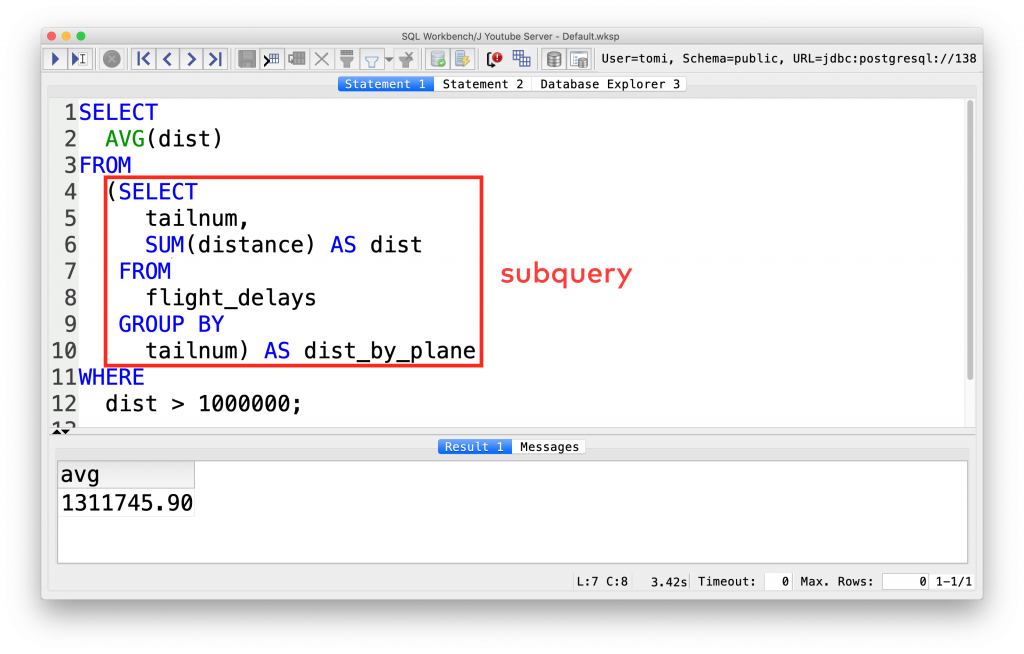
See? Nothing new has happened here – only that we put a query into another query. That’s what SQL subqueries are about.
By the way, there is an alternative solution for this task using SQL HAVING… And I’ll get back to that soon.
The Junior Data Scientist's First Month
A 100% practical online course. A 6-week simulation of being a junior data scientist at a true-to-life startup.
“Solving real problems, getting real experience – just like in a real data science job.”
SQL CASE (the “if statement” of SQL)
Let’s say we want to see how many planes departed early, late or on time. With our current toolset we can do this by running 3 queries – one by one.
E.g. the number of flights that departed right on time would look like this:
SELECT COUNT(*) FROM flight_delays WHERE depdelay = 0 LIMIT 10;

To have all the variations you can change the = in the WHERE filter to < and to >.
The results will be:
- Departed early:
3515594 - Departed on time:
624472 - Departed late:
3135222
Good news! You can also do this using a single (slightly more advanced) SQL query if you use the CASE SQL keyword. Try this:
SELECT COUNT(*),
CASE WHEN depdelay < 0 THEN 'early'
WHEN depdelay > 0 THEN 'late'
ELSE 'ontime'
END as segment
FROM flight_delays
GROUP BY segment
LIMIT 10;
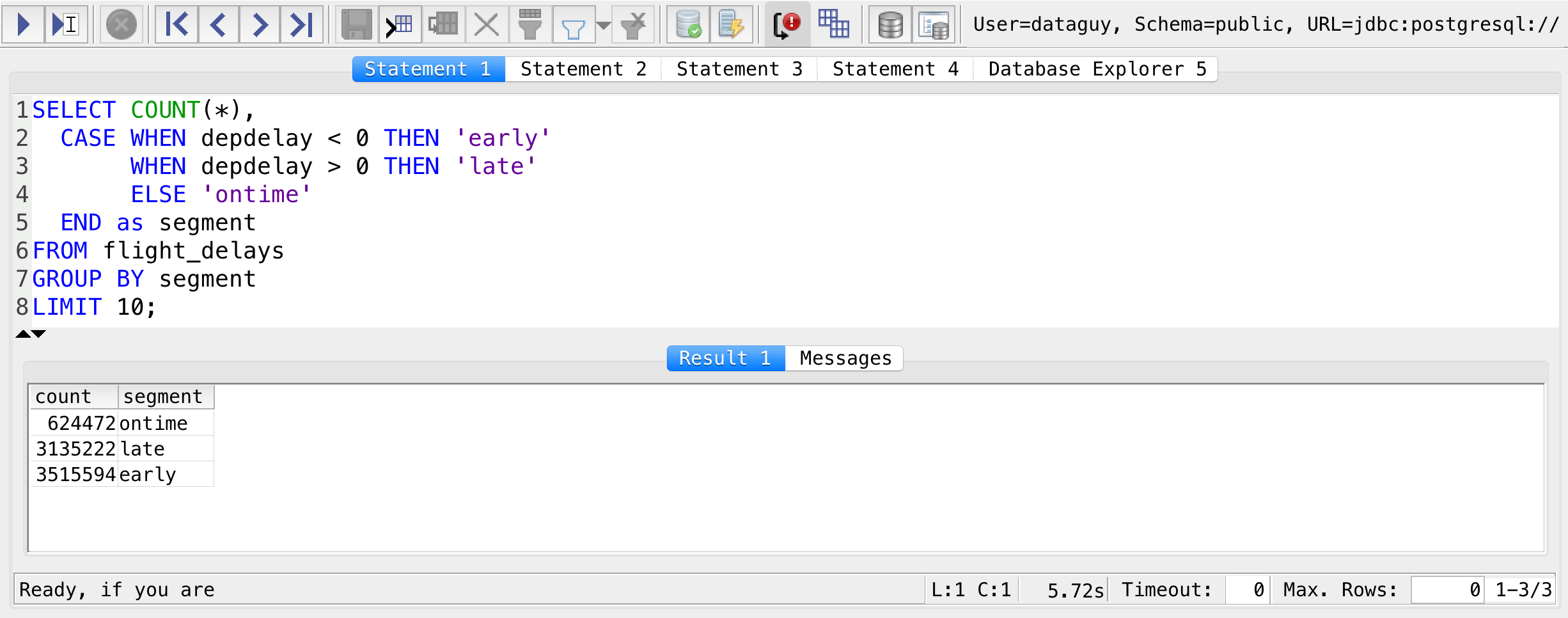
Nice, huh?
Let’s take a look at the new part:
CASE WHEN depdelay < 0 THEN 'early'
WHEN depdelay > 0 THEN 'late'
ELSE 'ontime'
END as segment
If you are familiar with if statements in bash or in Python, it’s not too hard to understand what’s happening here: the CASE WHEN part of your query categorizes the flights, based on the depdelay column, into 3 categories.
Note: if it’s not clear to you at first sight, I recommend running the query without the GROUP BY, like this:
SELECT *,
CASE WHEN depdelay < 0 THEN 'early'
WHEN depdelay > 0 THEN 'late'
ELSE 'ontime'
END as segment
FROM flight_delays
LIMIT 10;
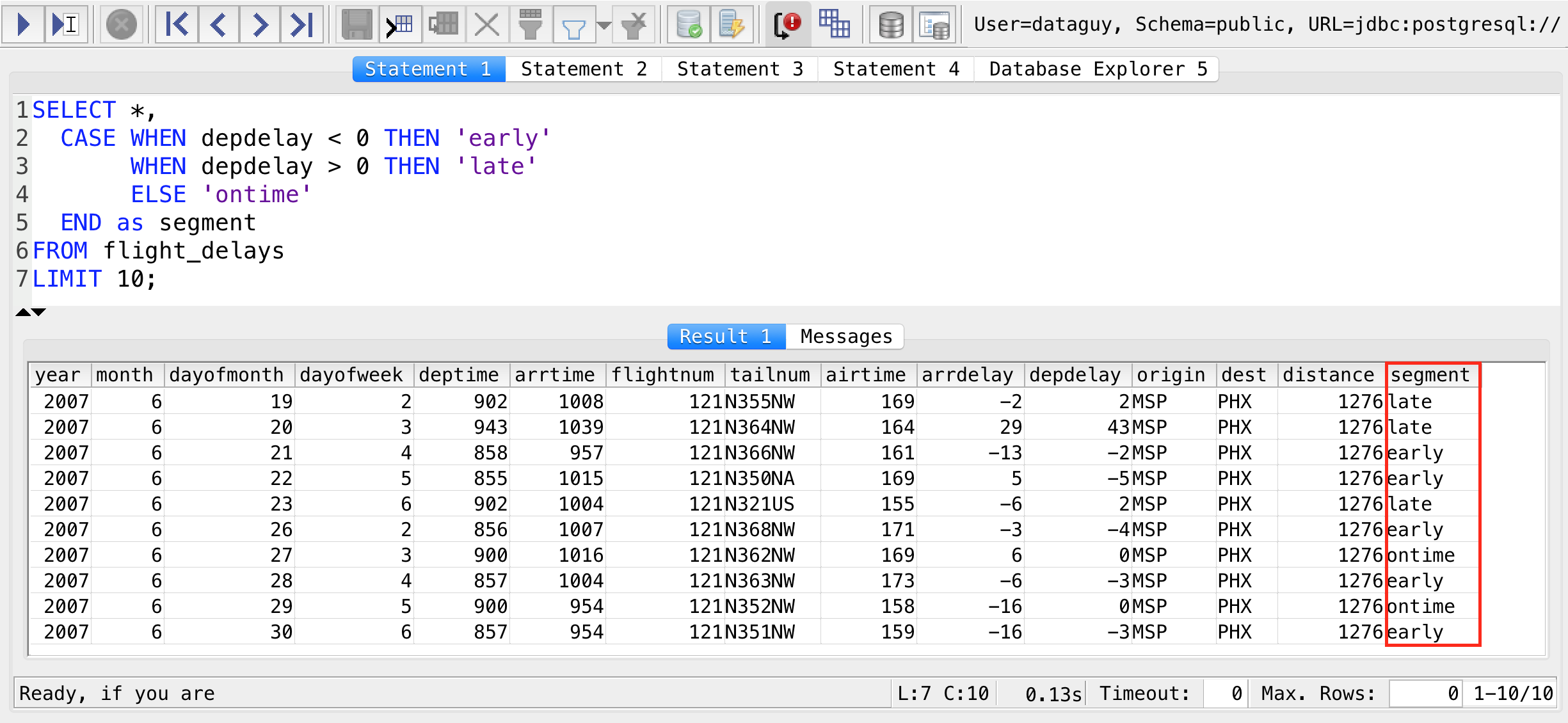
See? The trick is that the CASE WHEN statement is creating a new column at the end of the table.
To be honest I don’t use the SQL CASE statement too often during my daily job… but sometimes it’s very handy when I have to do some quick and dirty data cleaning/transformation, turn a continuous value into a categorical value (like we did in the above example), and so on…
SQL HAVING
You will need SQL HAVING for complex queries.
HAVING is for filtering on the results of SQL functions like COUNT(), SUM(), AVG(), etc.
But wait? Isn’t the WHERE keyword for filtering in SQL?
Yes but here’s the thing: in SQL, you can’t use WHERE with the results of aggregate functions. Why is that? Here’s a short explanation!
Let’s say we want to query something simple from our table: how many times an airport shows up in the table. You should go with this query:
SELECT COUNT(*) as nmbr,
dest
FROM flight_delays
GROUP BY dest;
Good.
Now we want to see only those airports that show up more than 10,000 times (means that the result of COUNT(*) is greater than 10000).
Someone new to SQL would try this (and I have to admit it might seem to be highly logical at first…)
BUT THIS QUERY WON’T(!) WORK:
SELECT COUNT(*) as nmbr,
dest
FROM flight_delays
GROUP BY dest
WHERE nmbr > 10000;
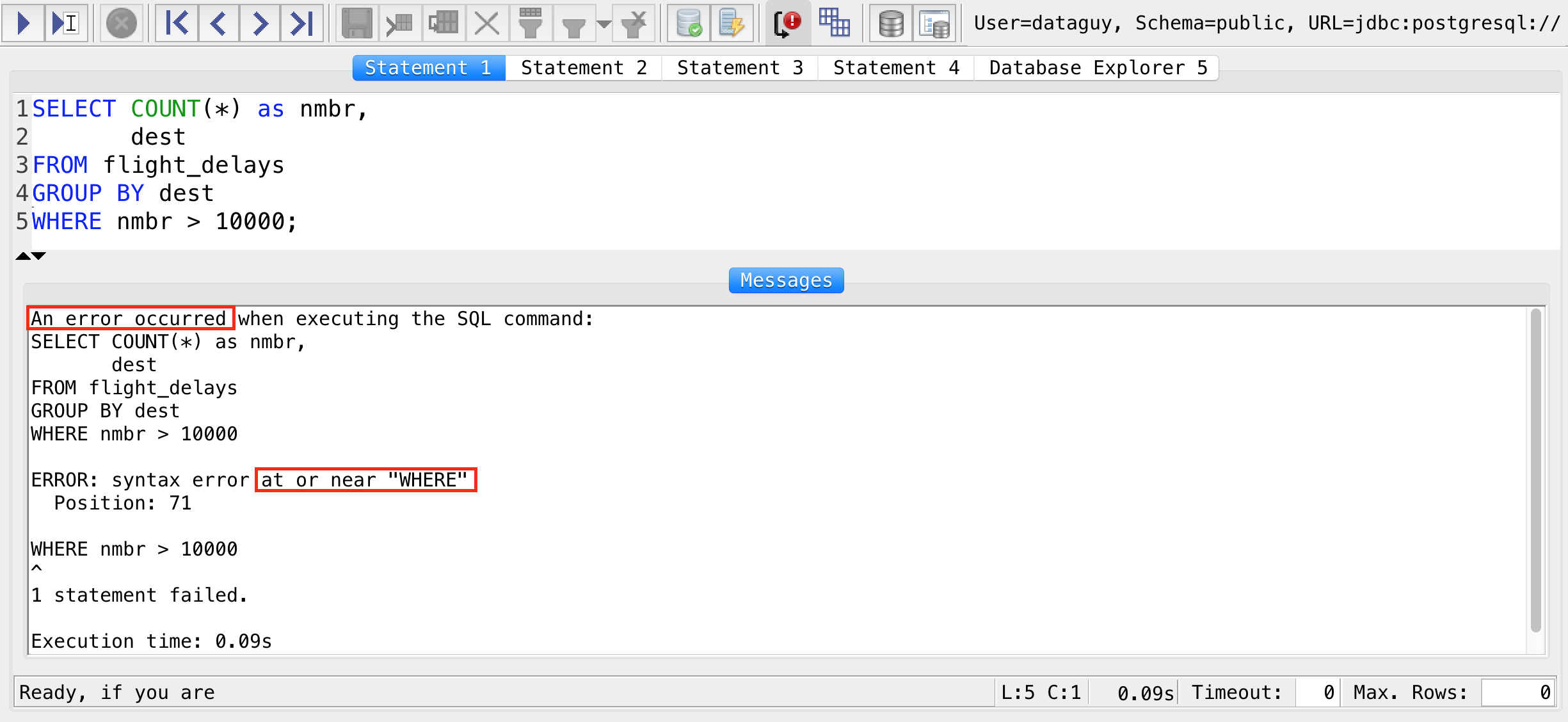
Yes, it looks logical, but again: this query won’t work. Why? The answer is in my previous article (SQL best practices)… But I am going to highlight it here as well. This is the order of the SQL keywords your computer sees when processing your query:
FROMJOIN,ONWHEREGROUP BYSELECTDISTINCTORDER BYLIMIT
As you can see, WHERE comes before GROUP BY and SELECT. This means that any aggregation column created by your GROUP BY clause can’t be part of your WHERE filter. And that’s where the SQL HAVING keyword comes into the picture. HAVING is the new WHERE – at least for the aggregated values in your SQL query. (Okay, this sounds very nerdy.)
You have to change your previous wrong query to this:
SELECT COUNT(*) as nmbr,
dest
FROM flight_delays
GROUP BY dest
HAVING COUNT(*) > 10000;
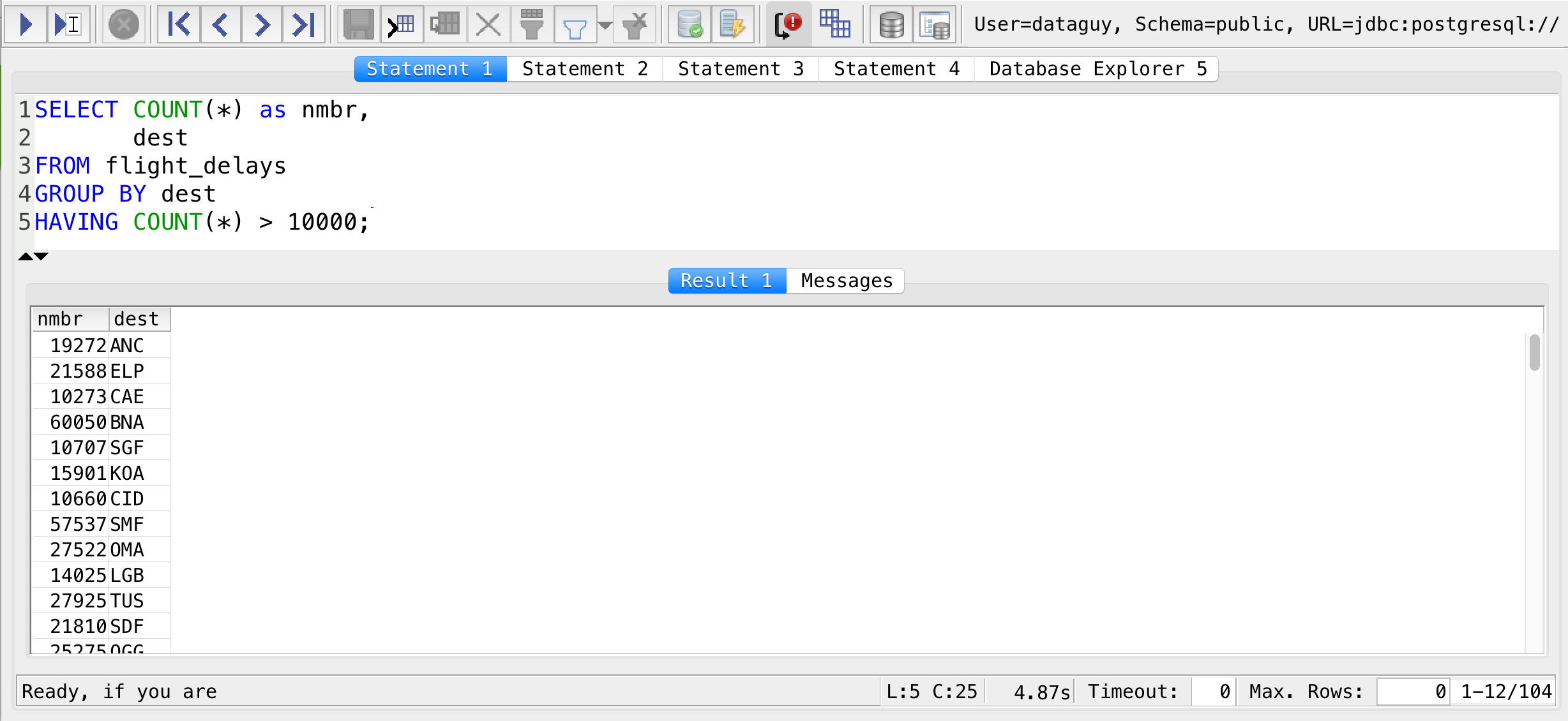
And it’ll just work!
The only unfortunate thing is that you can’t use your aliases with your HAVING, so you need to type the whole COUNT(*) function again… But we can deal with that!
Test yourself #2 (alternative solution with HAVING)
Let’s try to solve the same task that we had in TEST YOURSELF #1… Only this time, try to take advantage of HAVING, as well! So:
- Calculate the total of the distances flown by each plane… (Note: do the grouping based on the
tailnumcolumn — andSUMthe values in thedistancecolumn) - …then take only those planes for which this total distance is greater than 1,000,000…
- then calculate the average of the total distances flown by these planes!
Hint 1: you need to tweak your previous query just a little bit!
Hint 2: The expected result is still: 1311745.90.
.
.
.
The solution is:
SELECT AVG(dist) FROM (SELECT tailnum, SUM(distance) AS dist FROM flight_delays GROUP BY tailnum HAVING SUM(distance) > 1000000) AS dist_by_plane;
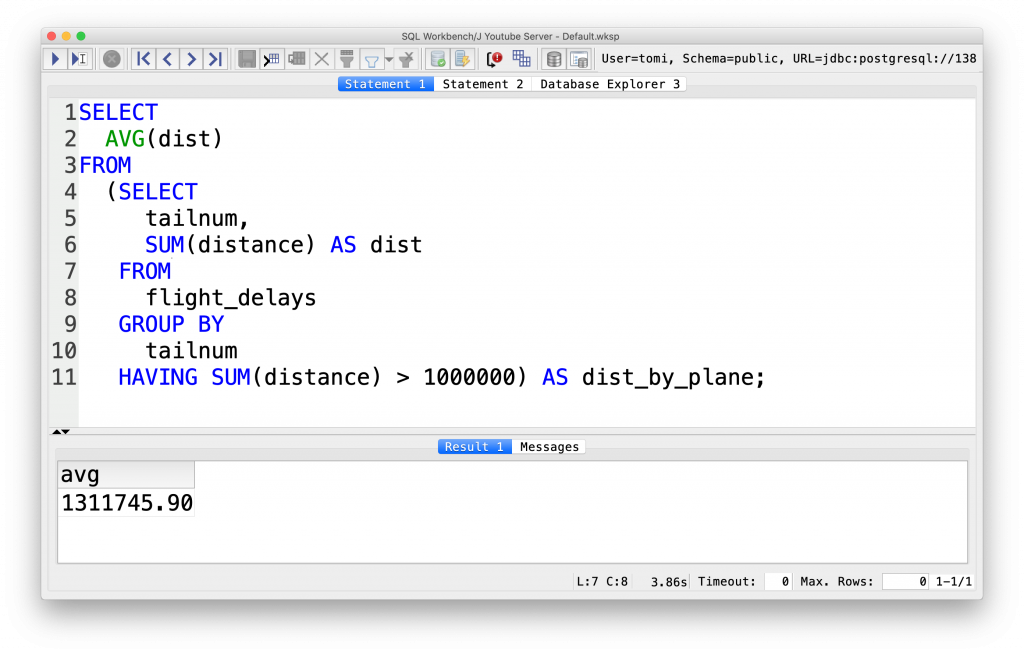
In this version, I’ve changed only one thing — instead of the WHERE in the outer query, I put a HAVING in the inner query. The result is the same. There might be slight differences in the computing time of the two solutions… But in this case, it won’t really matter.
Challenge: Is there a possible alternative solution by using CASE? 😉 Let me know: drop me an email!
Conclusion
Nice! These were some more advanced SQL concepts! And you have gone through them! Even better: you are done with the querying part of the SQL for data analysis tutorial series! Congrats!
If you have read and worked through all 6 episodes, you can proudly say that you know the basics of SQL. (You might also want to check out how to CREATE SQL tables.)
If you want to be better and more confident, let’s do these 3 things now:
- practice,
- practice and
- PRACTICE!
I’ve created a 7-day SQL course for that, by the way. It doesn’t just make you practice everything we learned so far but it also contains 20 job-interview-like SQL questions (and the solutions with explanations). Find more info here:
- If you want to learn more about how to become a data scientist, take my 50-minute video course: How to Become a Data Scientist. (It’s free!)
- Also check out my 6-week online course: The Junior Data Scientist’s First Month video course.
Cheers,
Tomi Mester
Cheers,
Tomi Mester

